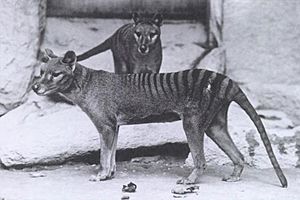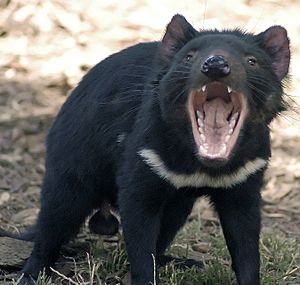Ecology of Tasmania facts for kids
Tasmania has amazing biodiversity, which means it has a huge variety of living things. This Australian state is a group of islands, with one large main island and many smaller ones. Its land has different reefs, small islands, and many unique areas. These features help create a very rich mix of plants and animals. For a long time, Tasmania was cut off from other lands. This allowed its plants and animals to become very special and found nowhere else. The climate here is like an oceanic one, meaning it's mild and wet.
Contents
Why is Tasmania's Nature So Special?
Long, long ago, the Earth's continents were joined together in a supercontinent called Gondwana. About 180 million years ago, Gondwana started to break apart. This led to Tasmania's plants and animals developing in almost complete isolation.
However, Tasmania was not always totally cut off. During ice ages, sea levels went down. This created land bridges or chains of islands between Tasmania and mainland Australia. These connections allowed new species to come to Tasmania. It also let some ancient Gondwanan species spread to the Pacific Islands.
Plants spread their seeds in many ways. Some seeds are carried by wind or water. Others are eaten by birds and bats, then dropped far away in their waste. Some seeds stick to birds' feet or feathers, traveling long distances. This is how many plants, algae, and even tiny animal eggs can reach new, faraway places.
Tasmania's Amazing Plants

Some of Tasmania's oldest plant groups come from a time over 200 million years ago. Back then, all continents were part of one giant landmass called Pangaea. This supercontinent later split into two parts: Laurasia (North America and Eurasia) and Gondwana (the southern continents). This explains why similar plants are found in places like South America, New Zealand, and Australia, even though they are far apart today.
Millions of years ago, Antarctica was much warmer and wetter. It had forests of plants like podocarps and southern beech. Antarctica was part of Gondwana. When Gondwana broke up, about 110 million years ago, the continents drifted apart. About 30-35 million years ago, South America separated from Antarctica. This caused Antarctica to become very cold. The ancient plants died out there, but they still live in southern South America and Australia, which were also part of Gondwana.
Many plant types that started in the ancient Antarctic flora are still found in places like New Caledonia, Tasmania, mainland Australia, and New Zealand.
Tasmania has three types of Nothofagus (southern beech) trees. The myrtle beech (Nothofagus cunninghamii) grows in places like the Tarkine Forest. The deciduous beech (Nothofagus gunnii) is found in the mountains of Tasmania.
As Australia drifted north, it became drier. The humid plants from Antarctica mostly stayed on the east coast and in Tasmania. Other parts of Australia became home to plants like Acacia and Eucalyptus. When humans arrived in Australia about 50,000 to 60,000 years ago, they used fire. This changed the plant life across the continent.
Tasmania has a huge variety of plants. You can find grasslands, tall eucalypt forests, alpine heathlands, and large areas of cool temperate rainforests. Many plant species are unique to Tasmania. Some are related to plants in South America and New Zealand. Their ancestors grew on the supercontinent of Gondwana about 50 million years ago.
Wet eucalypt forests grow in places with lots of rain, like the south, west, and northwest. Dry eucalypt forests grow where there is less rain, such as the east coast and midlands.
Tasmania is home to some of the world's oldest trees. For example, some Huon pines are over 2,000 years old. A group of male Huon pines at Mount Read has been growing for more than 10,000 years!
The tallest trees in the Southern Hemisphere are also in Tasmania. These include Eucalyptus regnans, Eucalyptus globulus, and Eucalyptus viminalis. They can grow to be 99 meters (325 feet) tall or more. Tasmania also has plant types found nowhere else, like Archeria.
Millions of years ago, these types of humid forests covered much of the Earth's warmer regions. The plants in Tasmania are like living fossils. They are remnants of forests that once covered large parts of Australia, South America, and Antarctica. As climates changed, these humid forests shrank. Many species died out because they couldn't cross new oceans or mountains. But some found safe places in coastal areas and on islands like Tasmania.
Today, Tasmania's island climate is kept mild and wet by the surrounding oceans. This has allowed these ancient plant communities to survive. The unique conditions and isolation of the island have helped protect them.
Tasmania's Amazing Animals
Tasmania's animals also show strong links to ancient Gondwana.
Invertebrates
A great example is the "mountain shrimp," Anaspides tasmaniae. It looks very much like 230-million-year-old fossils! Its closest relatives today are found in New Zealand and South America. The Tasmanian cave spider is one of the most ancient spiders in the world. It is the only member of its family found outside Chile.
Vertebrates
Animals with strong Gondwanan ties include a family of freshwater fish called Galaxiidae. Also, the two frog families in Tasmania (Myobatrachidae and Hylidae) and the parrots have ancient links. Echidnas and platypus also evolved from ancestors that lived in Gondwana. Close relatives of marsupials live in South America, and fossil platypus have been found there too.
During the ice ages, sea levels dropped many times. This allowed more animals to move between Tasmania and mainland Australia. This included five types of rodents and eight types of bats.
Thylacine (Tasmanian Tiger)

The island of Tasmania was once home to the thylacine, also known as the Tasmanian tiger. It was a marsupial that looked like a wild dog with stripes on its back. It died out on mainland Australia about 4,000 years ago, mostly because of competition with the introduced dingo. Sadly, the thylacine became extinct in Tasmania too. Farmers hunted them, and later, collectors for museums wanted them. The last known thylacine died in captivity in 1936.
The thylacine was the largest meat-eating marsupial of its time. It was one of only two marsupials where both males and females had a pouch. The male's pouch protected its reproductive organs while running. Adult thylacines were about 100 to 130 cm (39 to 51 inches) long, with a tail of about 50 to 65 cm (20 to 26 inches). They stood about 60 cm (24 inches) tall at the shoulder and weighed 20 to 30 kg (44 to 66 pounds). Males were usually larger than females.
Tasmanian Devil
The Tasmanian devil is a meat-eating marsupial found only on the island of Tasmania. It used to live on mainland Australia thousands of years ago. Devils are about the size of a small dog, but they are very strong and muscular. They have black fur with white patches. They are known for their loud, scary growls and their fierce temper. Tasmanian devils mostly eat dead animals.
Sadly, the Tasmanian devil population has dropped a lot recently. A disease called devil facial tumour disease has reduced their numbers by up to 80% in some areas. This disease causes tumours to grow on their faces. It is believed to spread when devils bite each other while fighting over food. The tumours make it hard for them to eat, and many devils starve.
Scientists are working hard to find a cure for this disease. There is also a special program to breed healthy devils in captivity. This helps create a group of devils free from the disease, in case the wild population continues to decline.
Birds

Many birds found on the Australian mainland also live in Tasmania. But Tasmania has 12 bird species that are found nowhere else in the world! These include:
- Four types of honeyeaters: the yellow wattlebird (the world's largest honeyeater), yellow-throated, black-headed, and strong-billed honeyeaters.
- Three types of Australo-Papuan warblers: the Tasmanian thornbill, the scrubtit, and the Tasmanian scrubwren.
- One pardalote: the endangered forty-spotted pardalote.
- One Australo-Papuan robin: the dusky robin.
- One cracticine: the black currawong.
- One parrot: the green rosella.
- One rail: the Tasmanian nativehen. This is Australia's only flightless land bird besides the large emu and southern cassowary.
The Tasmanian emu was a unique bird that became extinct in the mid-1800s. The Tasmanian wedge-tailed eagle is a special type of eagle found only here, and it is a threatened species.
Frogs

Tasmania is home to 11 species of frogs. Three of these are found only in Tasmania: the Tasmanian tree frog (Litoria burrowsae), the Tasmanian froglet (Crinia tasmaniensis), and the recently found moss froglet (Bryobatrachus nimbus). All 11 species are unique to Australia. Tasmania also has the largest group of growling grass frogs (Litoria raniformis), which is a vulnerable species that has declined in many other places.
European Red Fox
On June 20, 2001, Tasmania created a special group to get rid of the European red fox. Officials planned to spend a lot of money on this effort. Foxes are a big problem because they can harm native animals, farm animals, and ground-nesting birds. Experts believe there are fewer than 30 million foxes on mainland Australia, where they were brought by European settlers.
Since European settlement, about 28 native mammal species or subspecies have become extinct on mainland Australia. Red foxes are a major reason for this. Animals like the eastern barred bandicoot, eastern quoll, and Tasmanian pademelon have disappeared or are rare on the mainland, but they are still common in Tasmania. This shows how important it is to keep foxes out of Tasmania to protect its unique wildlife.
Over 40 fox droppings (scats) have been found across Tasmania and confirmed by DNA tests. This shows that foxes are indeed present in Tasmania. The government is working to control and remove them to protect the island's special animals.



